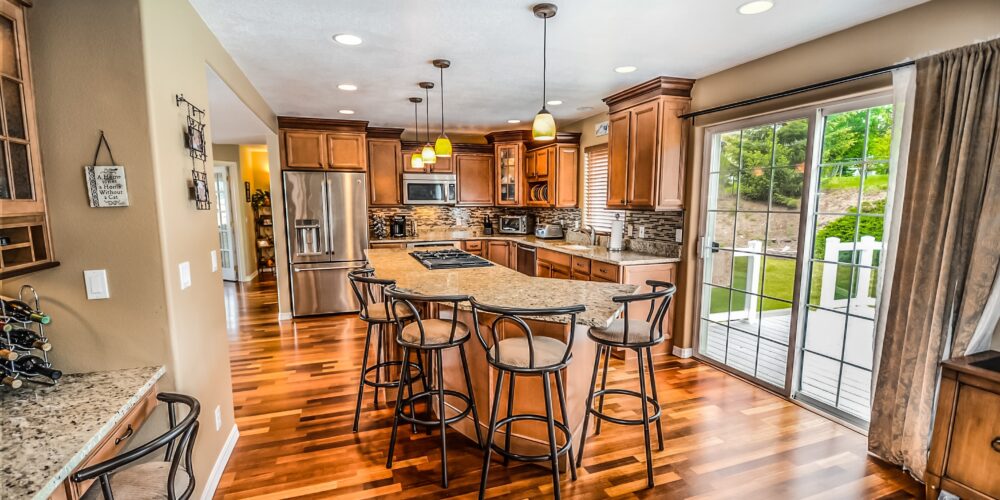
Japanese Zen Kitchen Oasis: Tranquility and Mindful Design
Embark on a journey to create a Japanese Zen-inspired kitchen oasis where tranquility, clean lines, and mindfulness converge. This blog post will guide you through the process of infusing your kitchen with the essence of Zen, incorporating elements of a Zen garden, a calming color palette, and a design that promotes serenity and balance.
Minimalistic Design: Clean Lines
Begin by embracing a minimalistic design with clean lines. Opt for streamlined cabinetry, sleek countertops, and uncluttered surfaces that foster a sense of simplicity and tranquility.
Natural Materials: Organic Aesthetics
Incorporate natural materials for an organic aesthetic. Wooden cabinetry, bamboo flooring, and stone countertops establish a strong connection to nature and the principles of Zen design.
Neutral Color Palette: Calming Tones
Choose a neutral color palette with calming tones. Soft whites, gentle grays, and muted earthy hues evoke a sense of serenity, allowing you to create a harmonious atmosphere.
Zen Garden Elements: Rock and Sand
Integrate Zen garden elements into your kitchen. A small area with smooth stones and raked sand serves as a mindful focal point, inviting a sense of calm reflection.
Sliding Shoji Screens: Versatile Separation
Consider sliding Shoji screens for versatile separation. These traditional Japanese screens made of translucent paper and wooden frames add privacy while maintaining an open feel.
Bonsai or Bamboo Plants: Nature’s Presence
Place bonsai trees or bamboo plants for nature’s presence. These miniature trees and plants symbolize balance and harmony, bringing a touch of the outdoors inside.
Open Shelving: Display Simplicity
Opt for open shelving to display simplicity. Arrange minimalist dishware, teapots, and utensils on open shelves, showcasing functional beauty and order.
Paper Lanterns: Soft Illumination
Hang paper lanterns for soft illumination. These delicate lanterns provide a gentle glow, creating an ambiance that encourages relaxation and mindfulness.
Muted Textiles: Tranquil Fabrics
Choose muted textiles for tranquil fabrics. Linen curtains, woven placemats, and soft cushions add tactile comfort without overwhelming the space.
Hidden Storage: Clutter-Free Space
Design hidden storage solutions for a clutter-free space. Concealed cabinets and drawers ensure that your Zen kitchen remains organized and visually serene.
Tea Ceremony Corner: Ritual Space
Create a tea ceremony corner for a ritual space. Place a low table and cushions for traditional tea ceremonies that embody mindfulness and connection.
Water Feature: Flowing Harmony
Incorporate a water feature for flowing harmony. A small tabletop fountain or a simple dish of water adds a soothing element of movement to your Zen oasis.
Muted Artwork: Subtle Beauty
Hang muted artwork for subtle beauty. Minimalist paintings, calligraphy, or nature-inspired prints complement the Zen aesthetic without overpowering it.
Feng Shui Principles: Balanced Arrangements
Apply Feng Shui principles for balanced arrangements. Consider the flow of energy and the arrangement of furniture to create a harmonious and inviting space.
Floating Islands: Open Space
Use floating islands for open space. Islands with open bases and minimalistic design contribute to a sense of spaciousness and accessibility in your Zen kitchen.
Minimalistic Tableware: Simple Elegance
Choose minimalistic tableware for simple elegance. White or earth-toned ceramics with clean lines and organic shapes enhance the Zen-inspired aesthetic.
Floor Seating: Intimate Gathering
Incorporate floor seating for an intimate gathering space. Cushions, zabutons, and low tables invite a sense of closeness and connection during meals.
Natural Light: Illuminating Serenity
Embrace natural light to illuminate serenity. Large windows or skylights allow sunlight to flow in, enhancing the calming and peaceful atmosphere.
Tatami Mats: Traditional Texture
Use tatami mats for traditional texture. These woven straw mats add authenticity and a sense of cultural grounding to your Zen kitchen space.
Floating Shelves with Succulents: Living Decor
Install floating shelves adorned with succulents for living decor. These low-maintenance plants bring a touch of nature and serenity to your kitchen.
Neutral Backsplash: Tranquil Background
Choose a neutral backsplash for a tranquil background. Subdued tiles or stone create a serene backdrop that complements the Zen aesthetics.
Translucent Screens: Soft Division
Consider translucent screens for soft division. Frosted glass or rice paper screens subtly separate spaces while allowing light to filter through.
Mindful Art: Contemplative Pieces
Hang mindful art for contemplative pieces. Paintings, sculptures, or calligraphy that convey serenity and mindfulness contribute to the Zen ambiance.
Stone Countertops: Natural Elements
Opt for stone countertops for natural elements. Smooth, cool stone surfaces like granite or marble reflect the simplicity and elegance of Zen design.
Wooden Tray Displays: Harmony in Arrangement
Use wooden tray displays for harmony in arrangement. Wooden trays with carefully arranged items, such as tea sets or utensils, evoke a sense of order.
Incense Burner: Aromatherapy Rituals
Incorporate an incense burner for aromatherapy rituals. Lighting incense can create a soothing and aromatic environment that enhances mindfulness.
Noren Curtains: Functional Art
Hang noren curtains as functional art. These split curtains with traditional designs add a touch of Japanese culture and artistic charm.
Japanese Kettle: Teapot Rituals
Place a Japanese kettle for teapot rituals. A traditional kettle for heating water embodies the tea ceremony’s reverence for simplicity and process.
Neutral Flooring: Seamless Flow
Choose neutral flooring for a seamless flow. Light-colored wood or stone flooring creates a sense of continuity and calm throughout your Zen kitchen.
Bamboo Blinds: Nature-Inspired Shade
Install bamboo blinds for a nature-inspired shade. These blinds diffuse light while adding an element of organic beauty to your Zen kitchen.
Quietude and Reflection: Mindful Ambiance
Lastly, prioritize quietude and reflection in your Zen kitchen. Create a space that encourages mindfulness, meditation, and a sense of inner peace as you go about your daily routines.
With these elements, you’ll be well-equipped to transform your kitchen into a Japanese Zen-inspired oasis that encapsulates the tranquility, mindfulness, and natural beauty of Zen design. The fusion of clean lines, neutral tones, and Zen garden elements will guide you toward a space that nurtures a sense of calm and harmony in your everyday life. Stay tuned for more insights and inspiration to elevate your Japanese Zen kitchen oasis.
